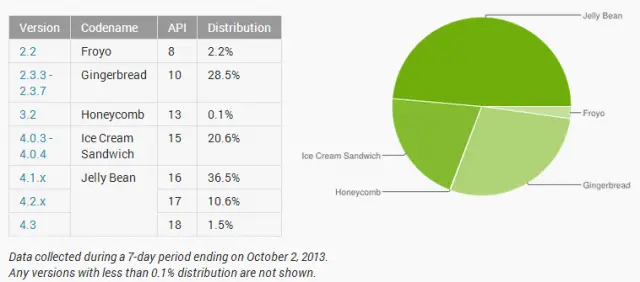
Latest Android platform numbers give Jelly Bean the clear lead, Gingerbread still kicking
Google has released the latest numbers which show us how much of the pie certain versions of Android have. These numbers are always interesting to take a look at from time to time, as they allow us to see how quickly newer versions of Android are being adopted (and how quickly older ones are dying). Unfortunately, older versions aren’t anywhere near dead in this latest update.
Gingerbread still controls a commanding 28.5% of the pie. It doesn’t seem like good news, but considering Gingerbread held a commanding lead for well over a year it’s definitely pleasant to our ears. That’s joined by another 2.2% from Froyo, which gives legacy versions close to a third of the share.
More contemporary versions of Android make up 69.2% of the share, though the various versions of Jelly Bean accounting for a vast majority of that with a combined 48.6%. Ice Cream Sandwich still has a significant take, though, with 20.6%. Google is also still showing Honeycomb on the chart with a measly 0.1%, though we expect that to disappear at some point in the very near future.
Jelly Bean’s dominance is no doubt a testament to Google’s new strategy, which calls for fewer major revisions of Android. While there were still several incremental upgrades to Jelly Bean since it was first released last year, Google has slowed down on adding major features to Android through platform changes.
Instead, they’ve opted to bring the most significant features to users through apps, which gives Google the ability to add new features to core apps without having to wait on the lengthy approval and testing processes of OEMs and carriers.
Decoupling as many features as they can and bringing them to us in the form of upgradeable apps should help solve the ever growing problem of fragmentation for the months and years to come. This is how Android was built to behave, and we’re glad to see Google finally taking advantage of that in a meaningful way.
Of course, with Android 4.4 Kit Kat on the way we’ll have to start keeping track of a new major version, and with that will likely come new major features. We’re not exactly sure what to expect in that regard just yet, though recent leaks have hinted toward updated system apps (namely the messenger and dialer). We should be seeing Google reveal the new OS shortly.
Google typically likes to wait until they have a new device to announce, something we expect to happen quite soon, as well. We’re talking about the Nexus 5, of course, a device that has found its way into the public eye in more ways than one.
It’ll be a joyous day when all of that is brought to light, but for now all we can do is sit, wait, and hope that Google has a lot of sweet surprises in store for us in the weeks ahead. Be sure to visit the Android developers’ site for the full chart and breakdown.

